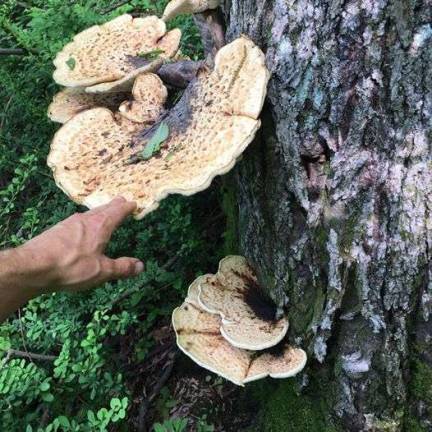The least daunting of wild mushrooms

Here’s a look at an easy to identify wild edible mushroom: the dryad’s saddle, or pheasant’s back (Cerioporus squamosus). The name dryad’s saddle refers to fairy-like entities in Greek mythology called dryads who were seen as tree-dwelling nymphs or sprites. Of course you will want to brush them off before collecting the mushrooms. And the name pheasant’s back derives from the pattern of colors on the bracket, matching that of a pheasant’s feathers.
These grow on various very dead hardwoods, oak, tulip poplar, maple, and especially elm. The best time to look for mushrooms like these is three days of sunshine after three days of rain. The rain helps the mycelium begin forming mushrooms, and the sun brings them out through the cracks. An important characteristic of identifying this mushroom is that when slicing a small piece, the mushroom smells like watermelon rind where cut.
This delicious and abundant mushroom always grows out of trees directly and has a white porous underside when fresh, which fades to a tan or bruised color – by then it’s too old for eating. It is recommended to eat the smaller specimens, even though you will find several which are bigger than dinner plates.
There are two ways to tell if your specimen is fresh. The first is to look on the underside and take note of how white and fresh the pore surface looks. The second is to slice a piece and look at the cross section. If you see a lot of bug holes or bugs, it’s past its prime as a choice edible, but may still be considered survival food.
When fresh and tender, the mushroom is delicious to sauté and add to any dish. You can also roast or dehydrate this mushroom, or powder it in a coffee grinder and add it to soups to enhance the flavor of stock. Mushroom soup is sure to please the senses, especially combined with some stinging nettle greens. I love to stir fry them in an oil like ghee or coconut oil with some onions and a little cumin seed. Dan de Lion